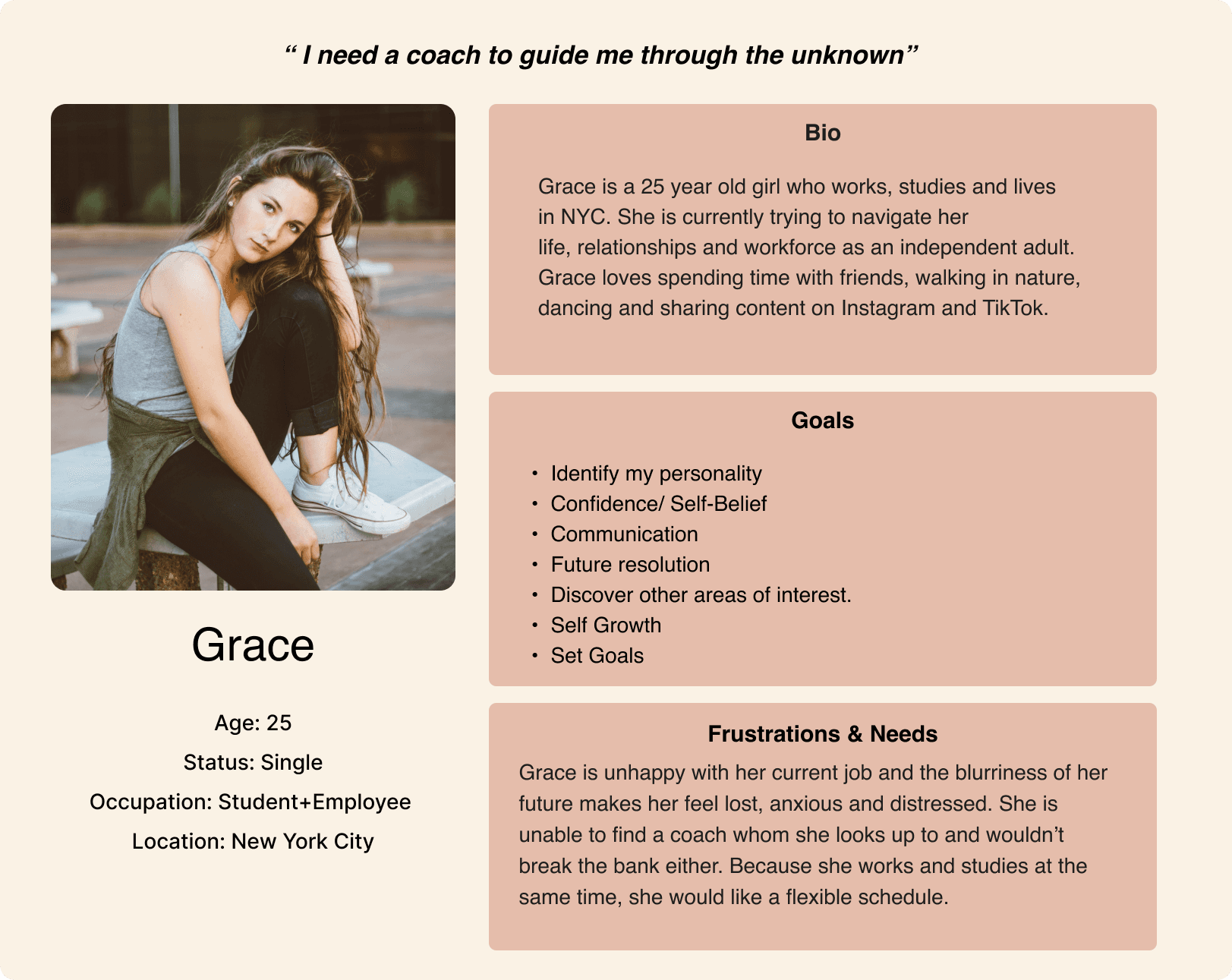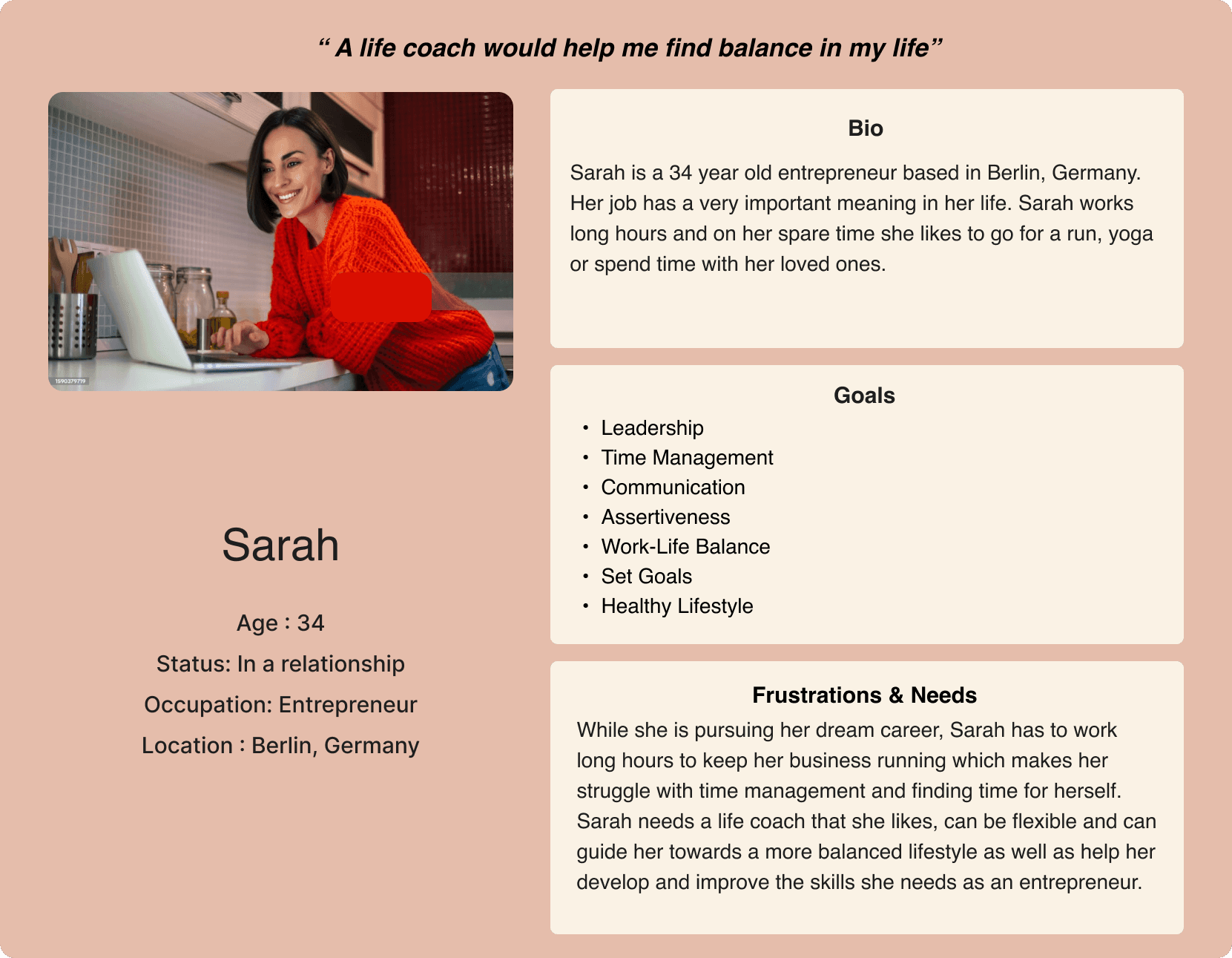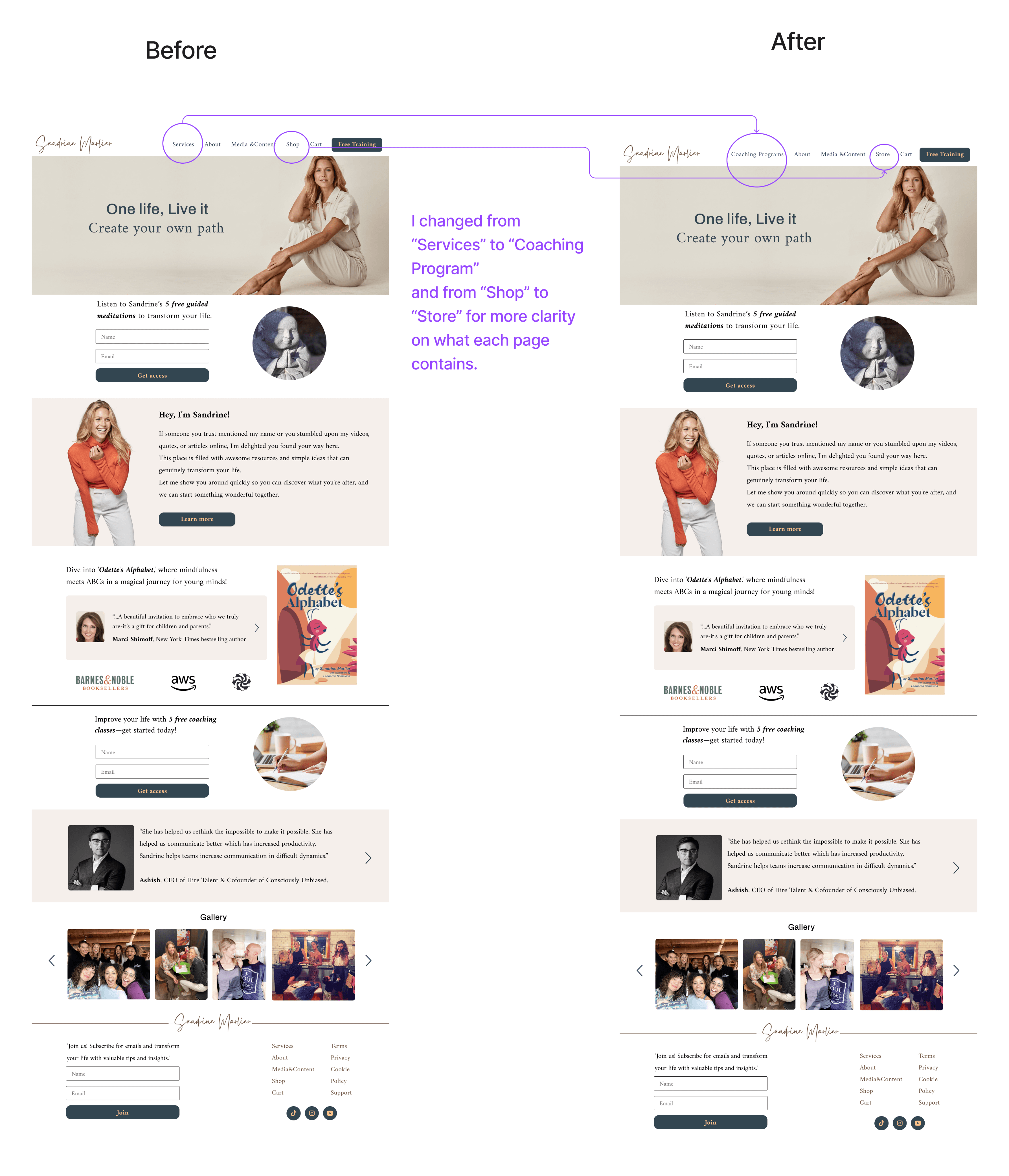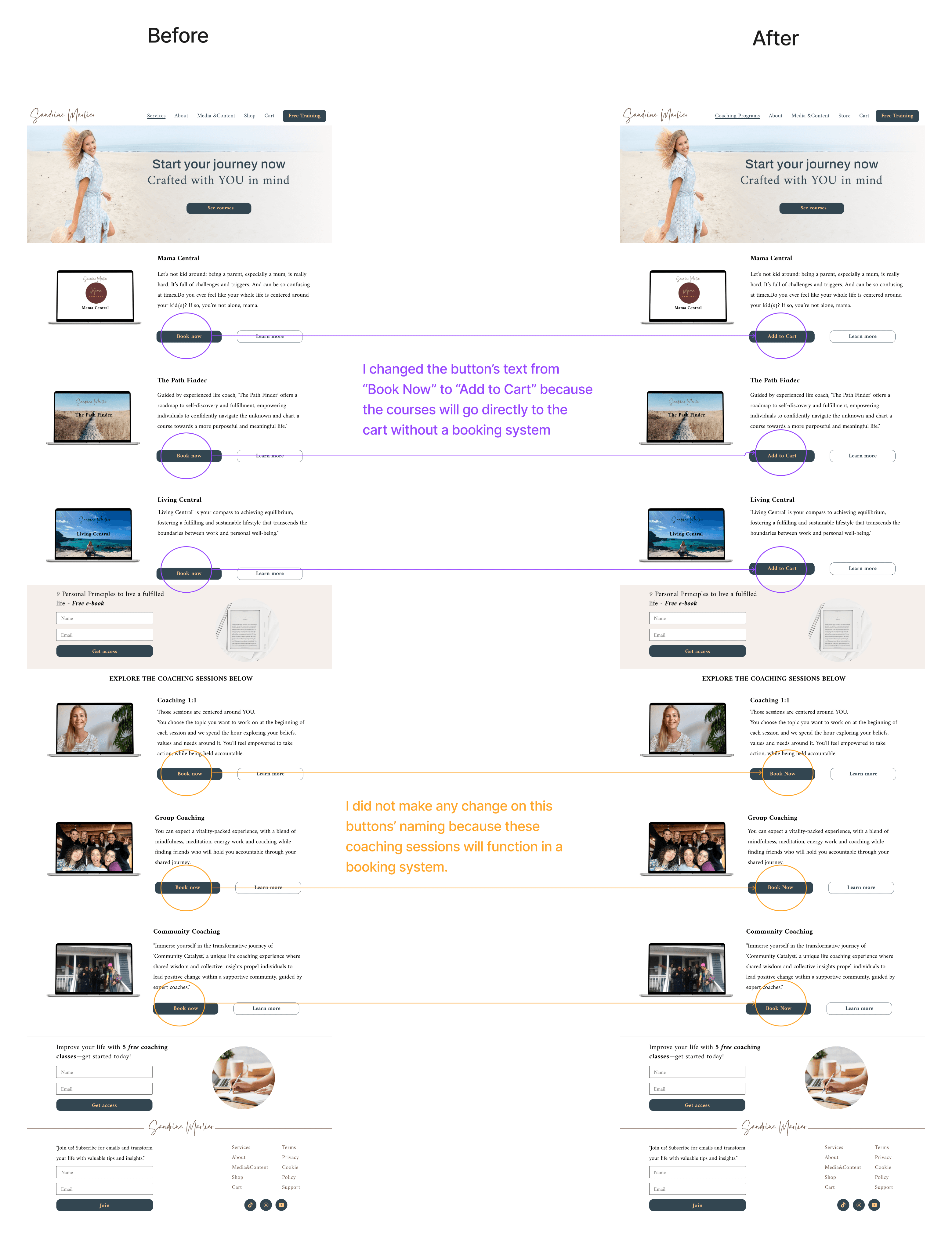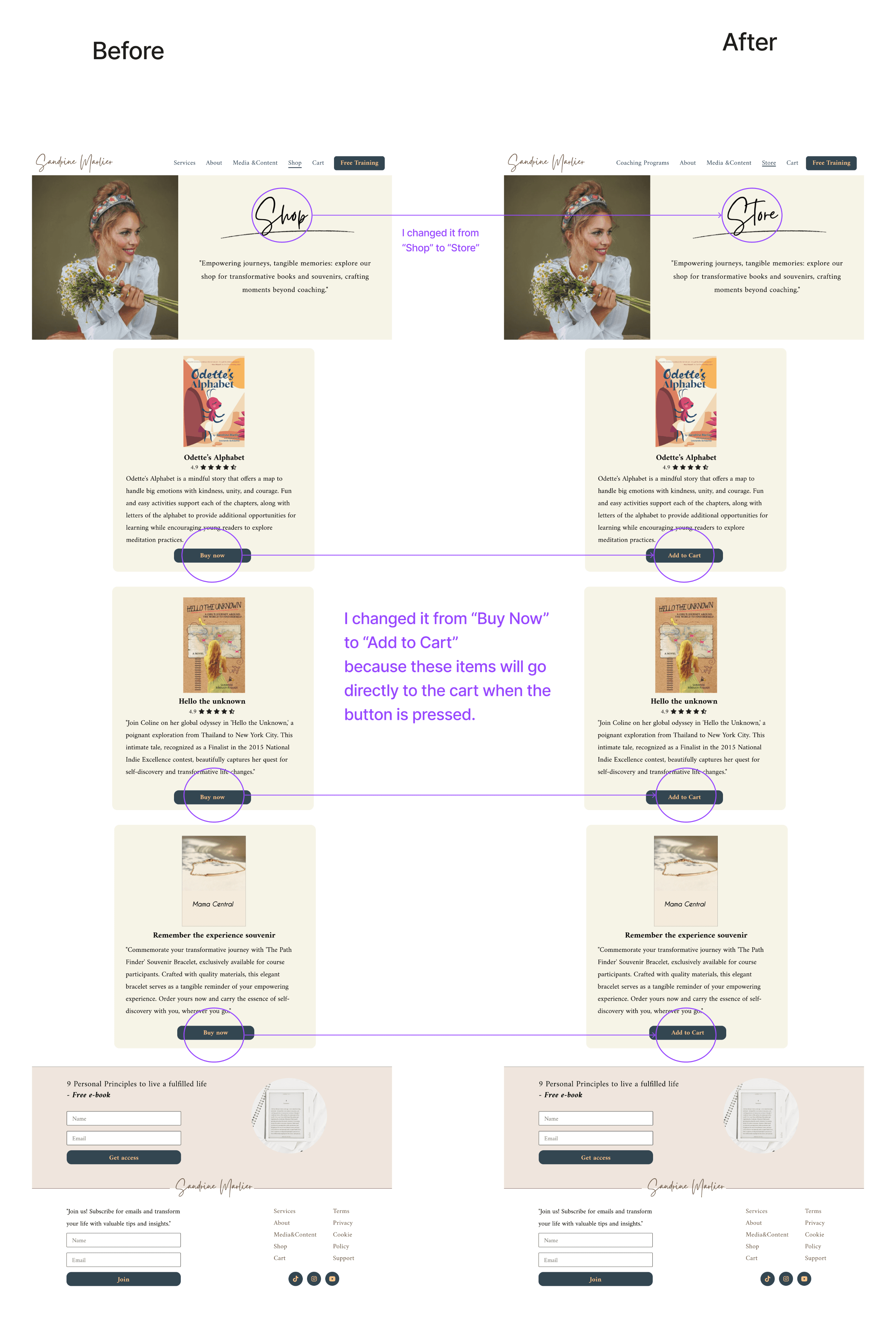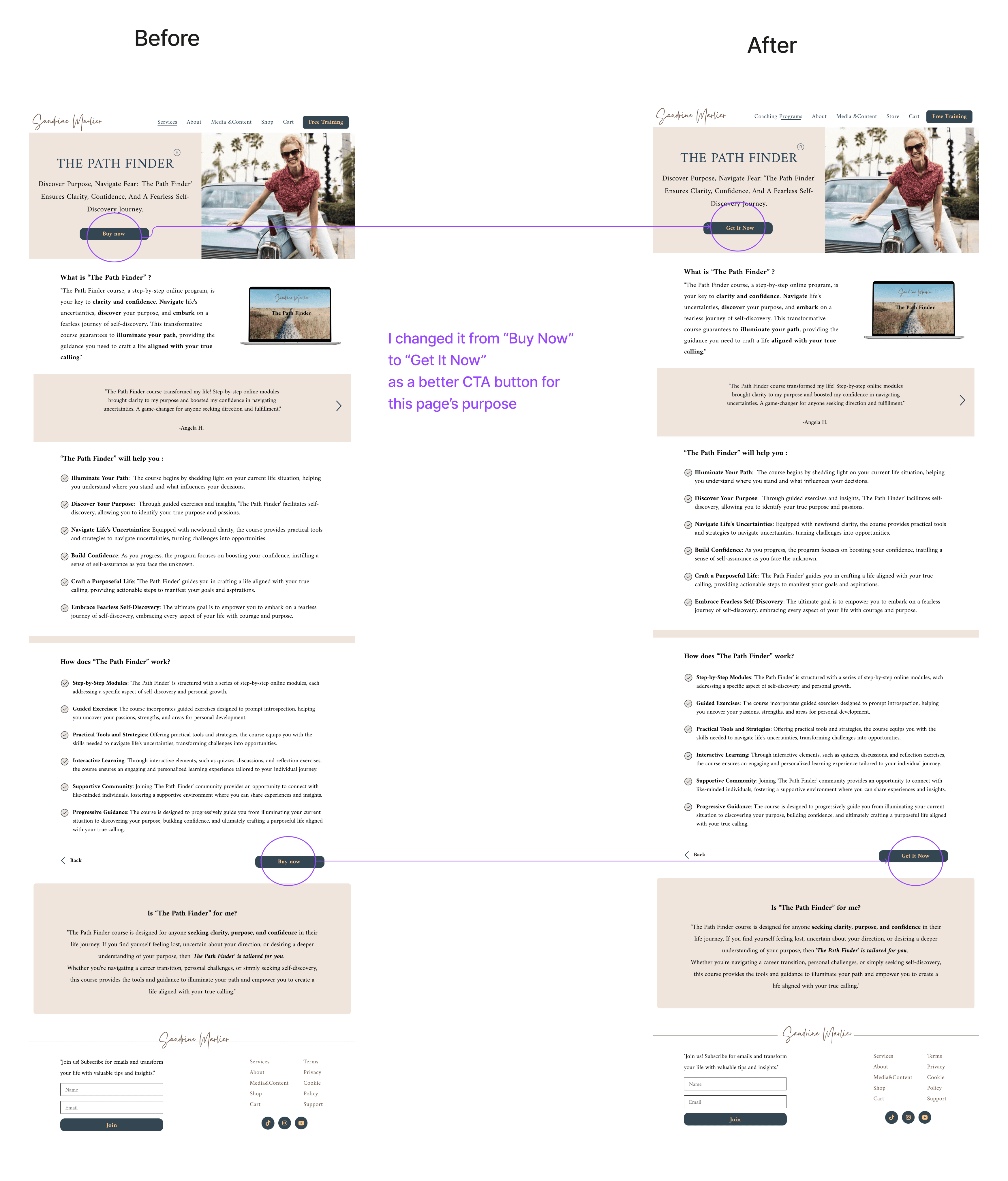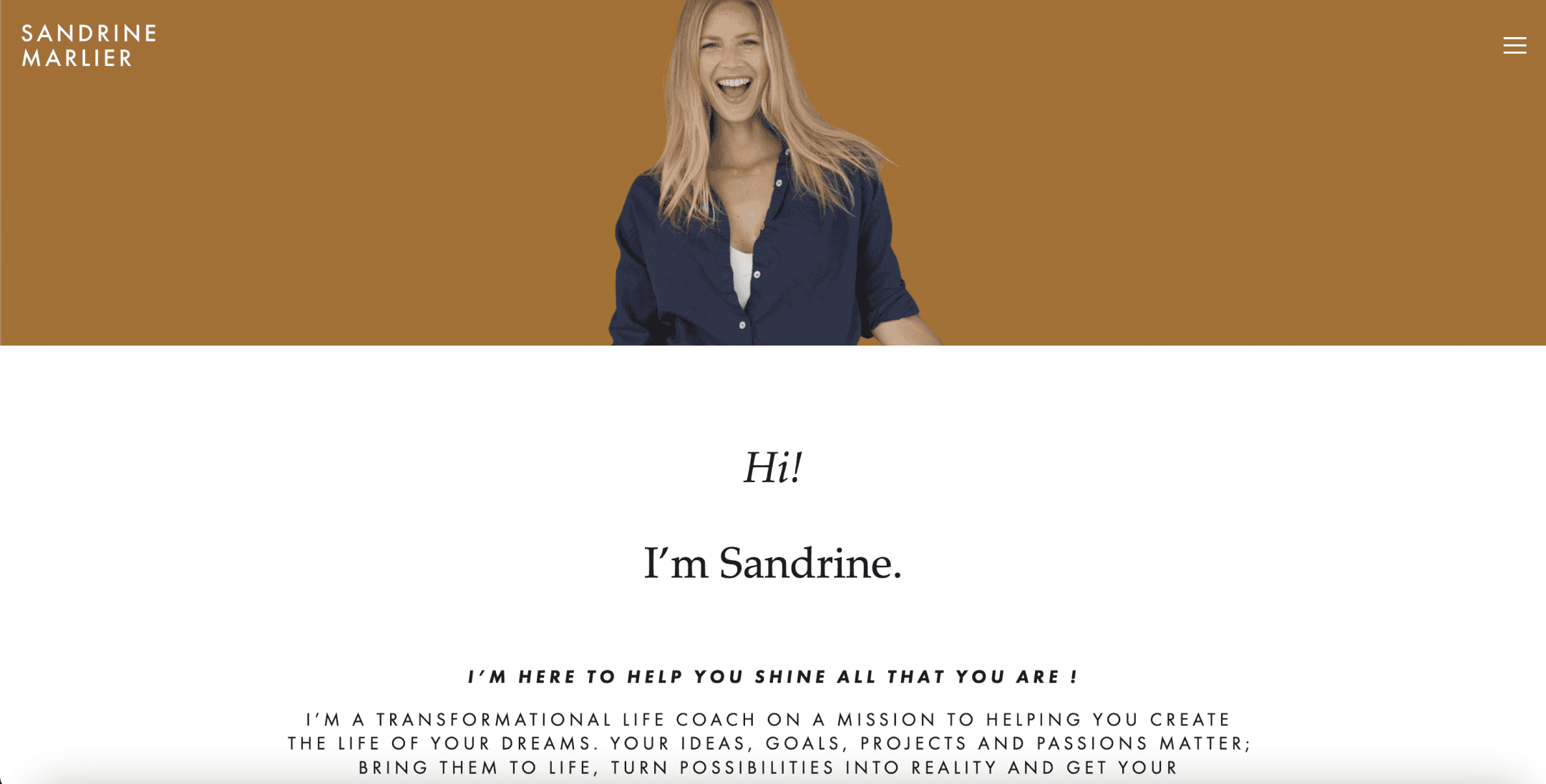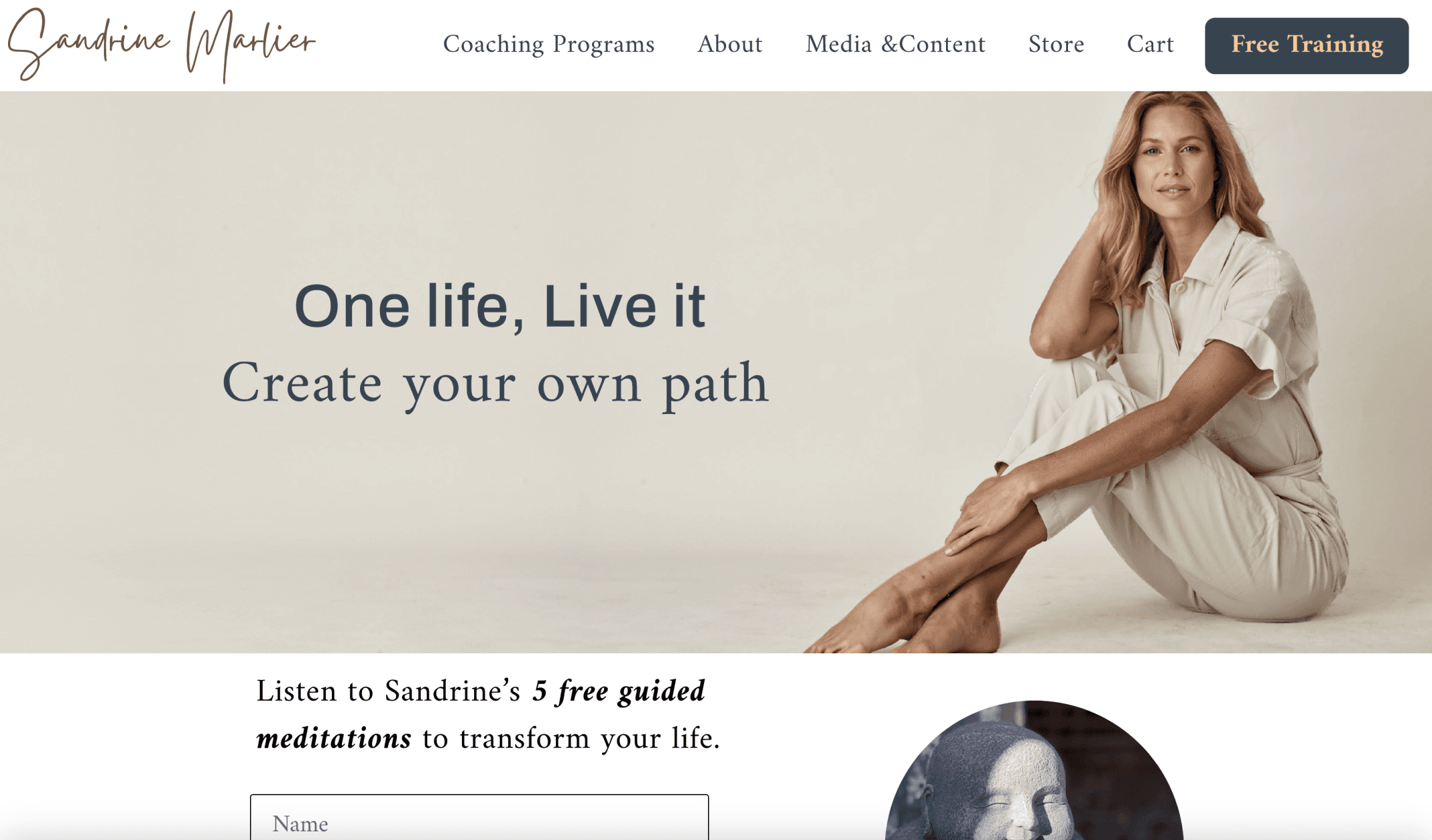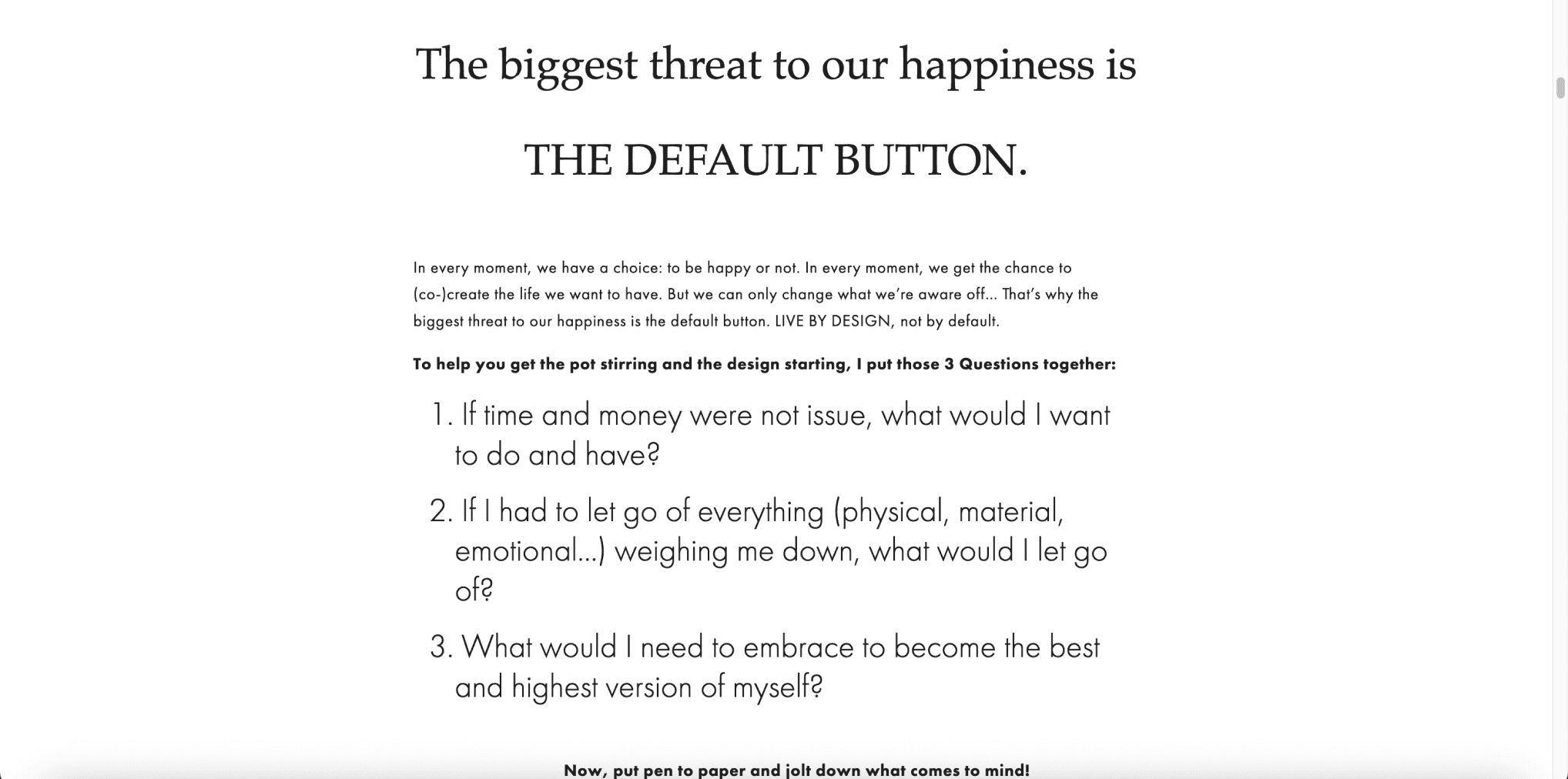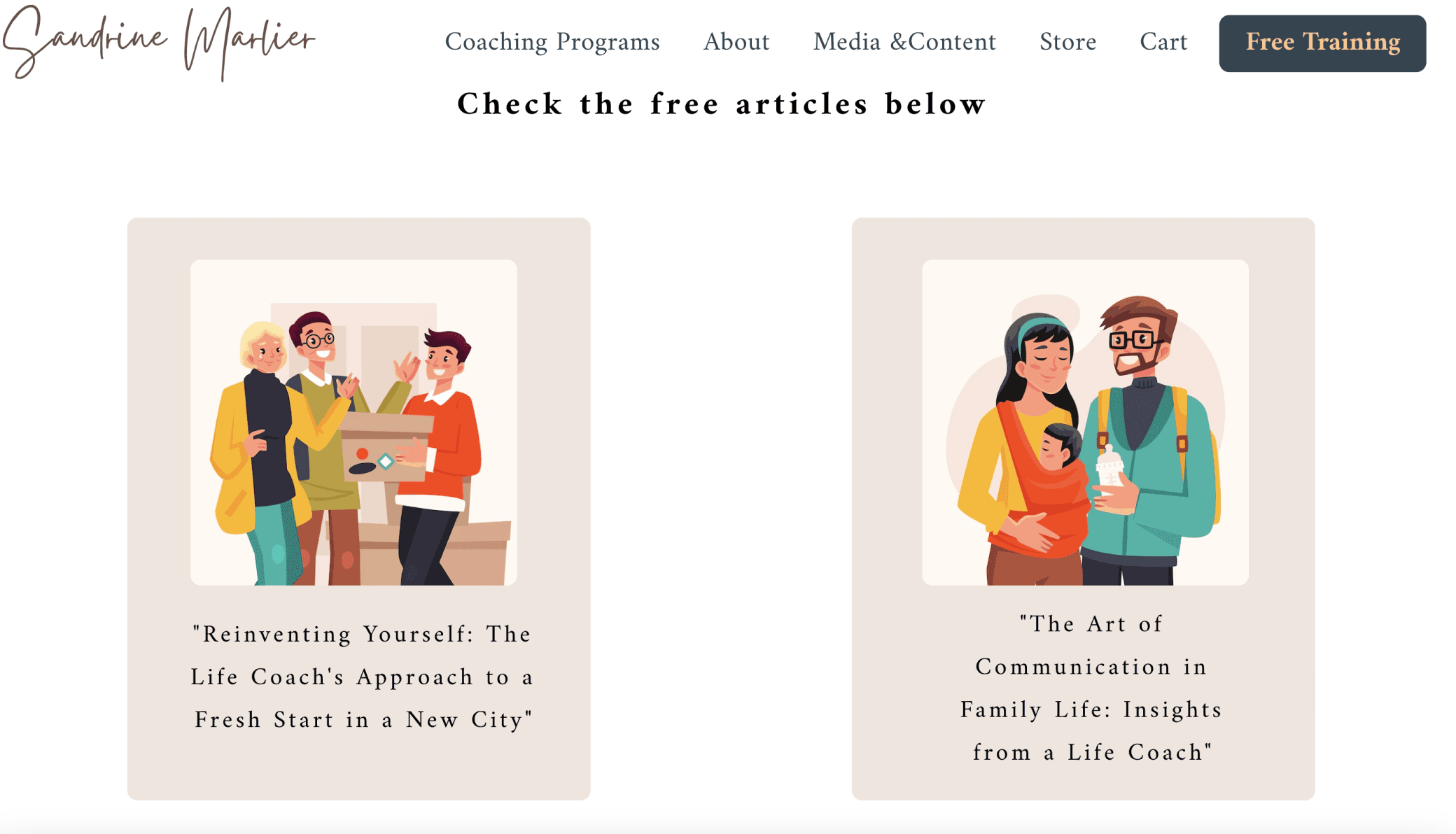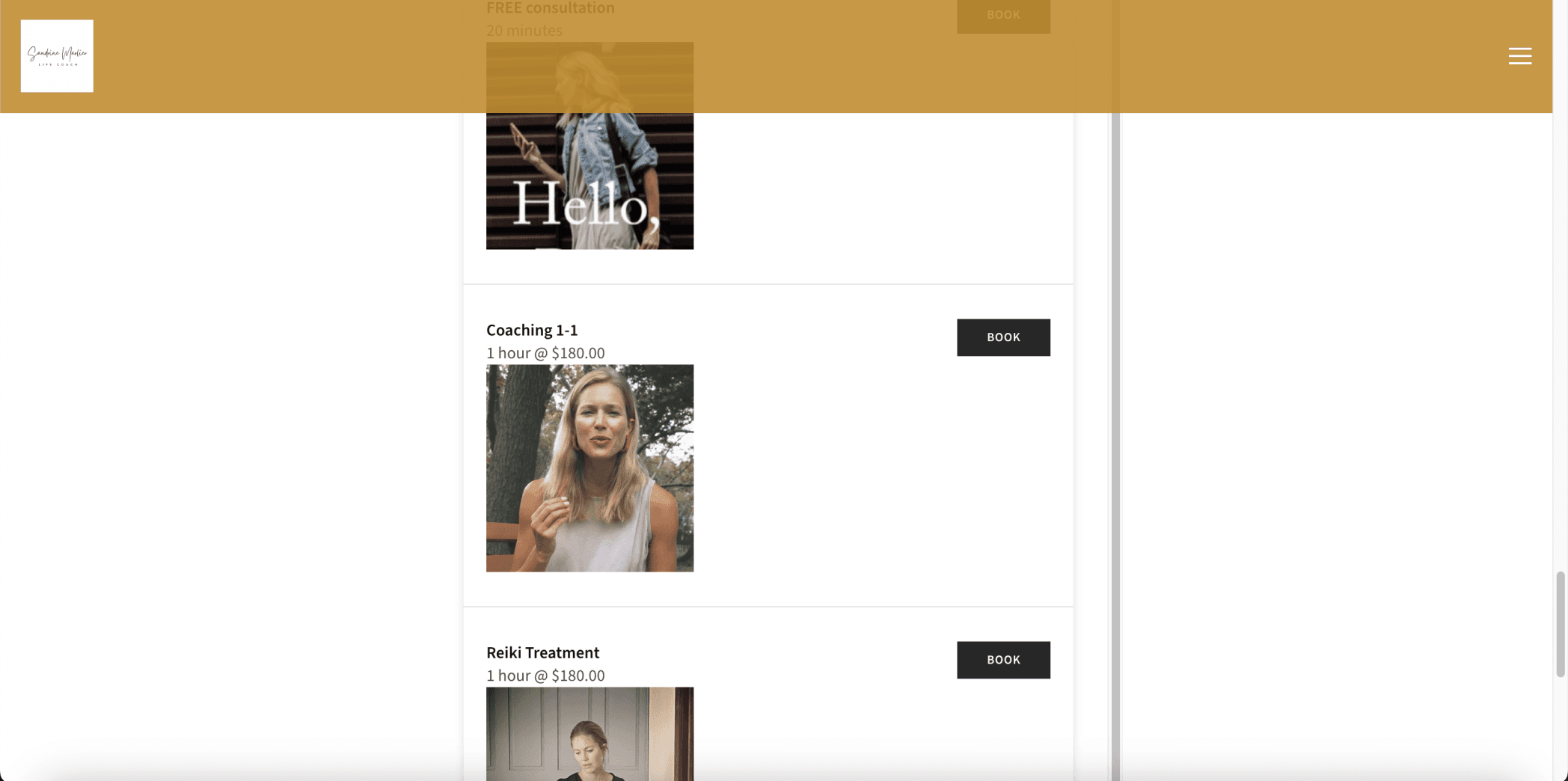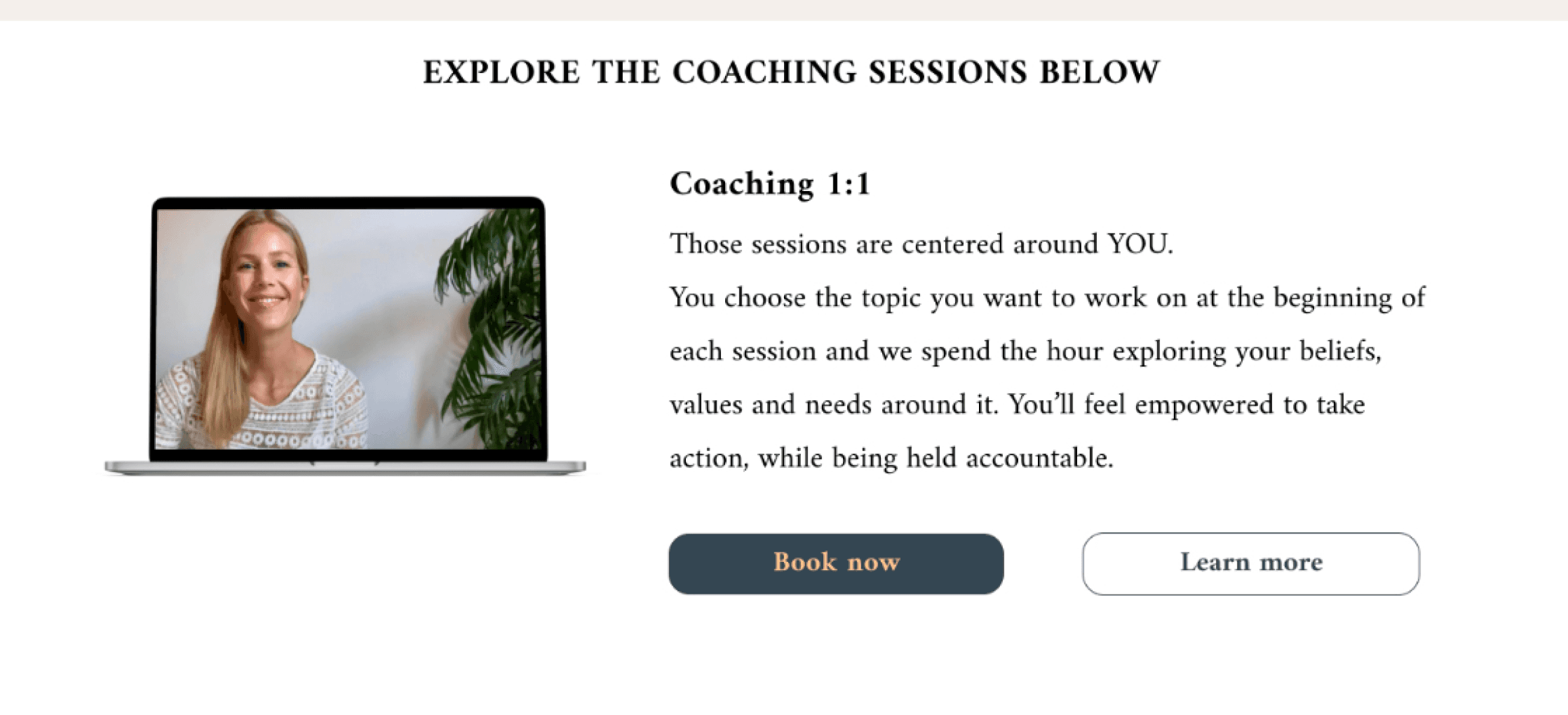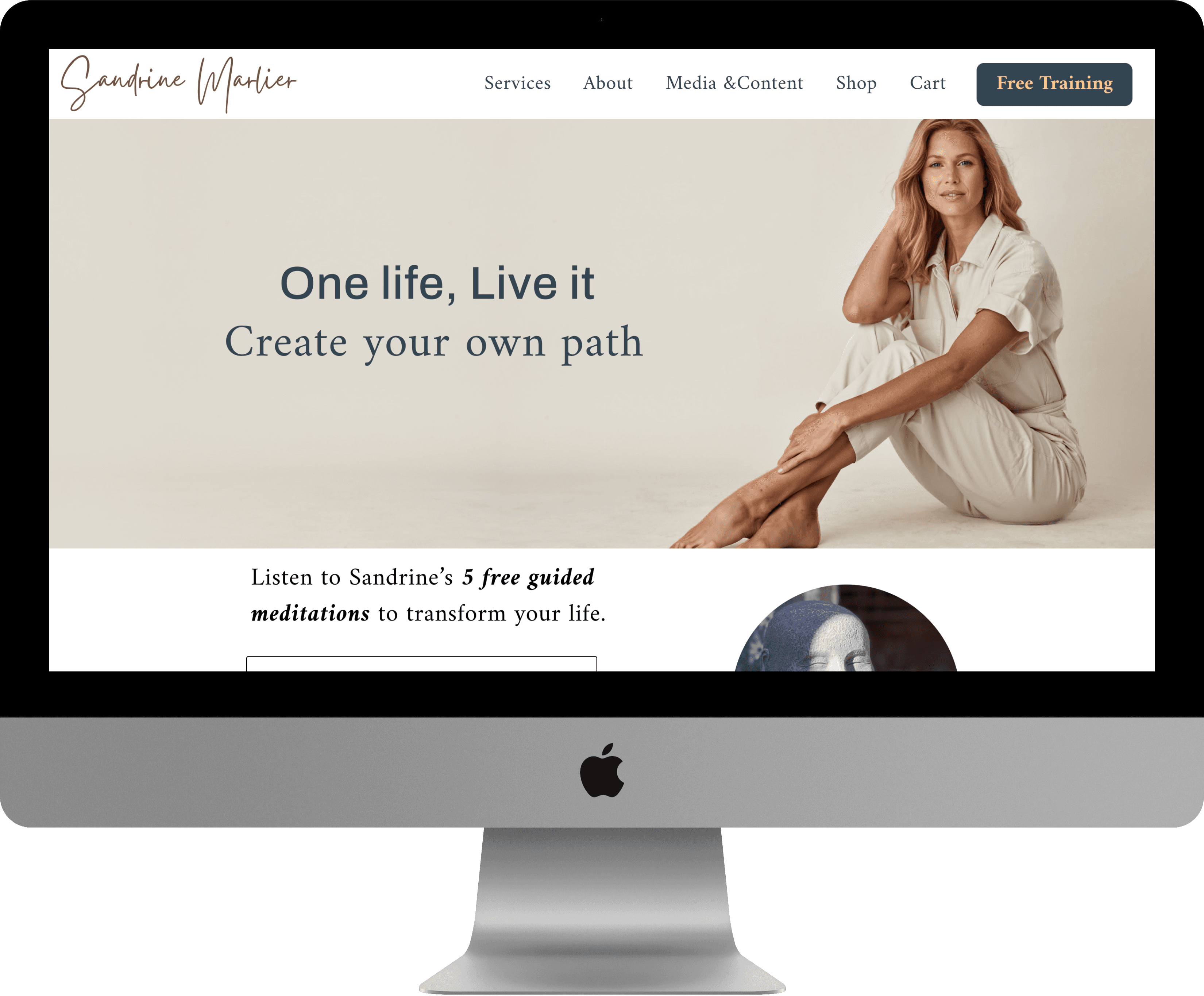
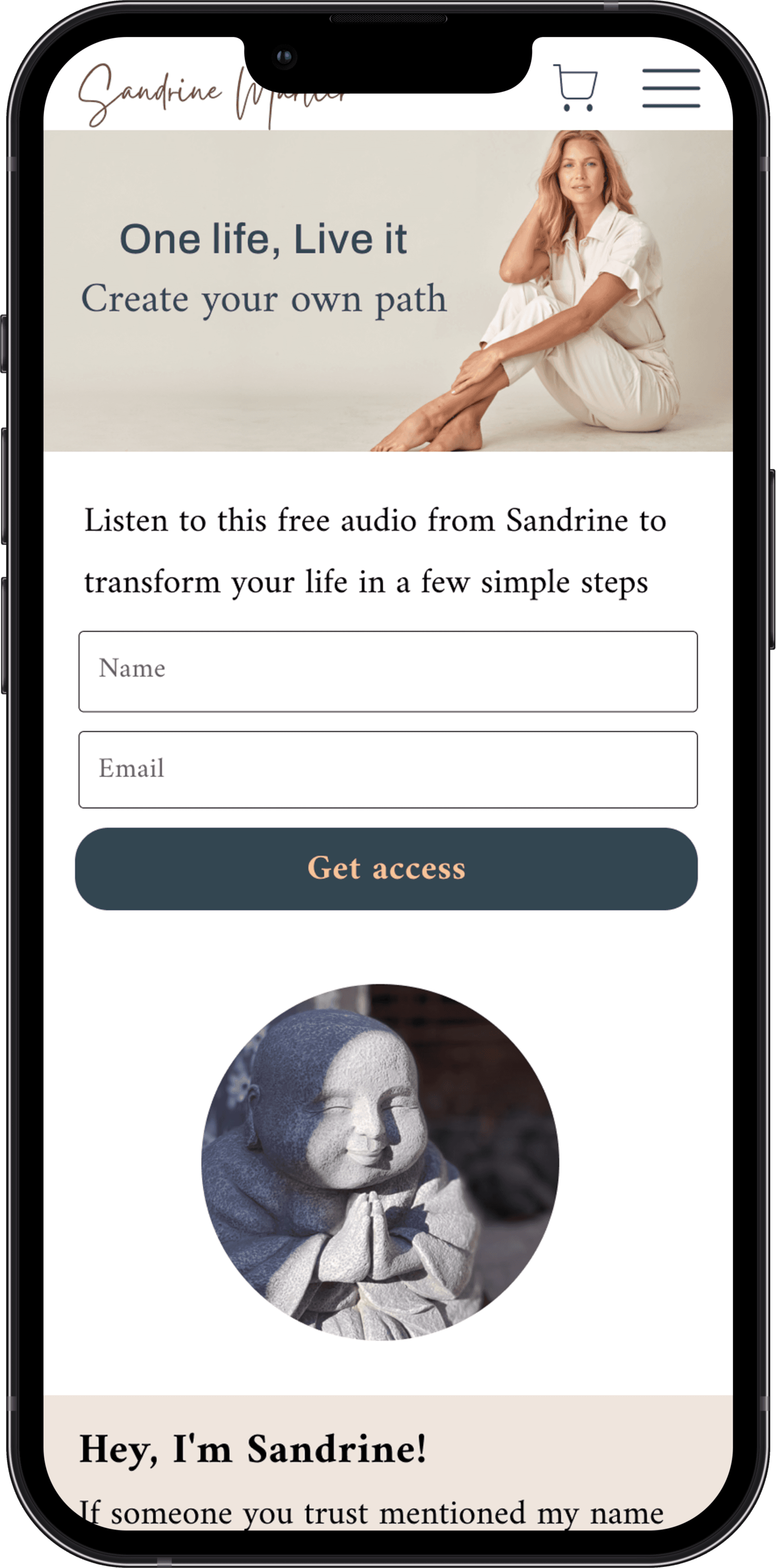
Project Overview
Sandrine Marlier
This project includes researching and understanding who the target audience is, understanding their needs and re-designing a responsive website for a better User Experience.
Tools
Figma
ChatGPT
Google Meet
Miro
Role
UX Researcher
UX Designer
UI Designer
Branding
Background
Sandrine Marlier is a professional life coach, meditation teacher, reiki master and author of children’ book. She has worked with many clients, helping them explore their values, strength and interests, setting goals, overcoming obstacles and guiding them towards their personal growth.
Problem
Throughout her career as life coach, Sandrine has been finding clients and developing her business mostly through her personal connections and her social media audience. She also owns a website built by her on Wix, where she represents her business. However, this website hasn’t been generating any clients and has not been helpful to the business. The actual website does not represent a niche and does not present well all the services and courses that Sandrine offers.
Research
Heuristic Evaluation
Through this part of research I realized that the business did not have a niche/ target clientele as well as identified areas for improvement to enhance user experience.
After I analyzed competitors to gain insights into their strategies, strengths, and operational methods, I was able to create patterns for my client’s business model. Each competitor has a specific niche.
Competitive Analysis
Surveys
Gathered quantitative data to understand the audience'sdemographics, preferences, and behaviors. I was able to note down a few areas of interest that are going to help in course designing.
User Interviews
Conducted in-depth interviews with target users to gather qualitative feedback, gaining insights into their needs, pain points, and preferences to inform user-centric design solutions.
POV & HMW
Defined the user's perspective and framed the problem as actionable questions to drive innovative solutions.
Before starting with the research methodologies I conducted an interview with the client to better understand their needs and goals:
Can you describe your business for me?
Client interview Takeaways
Business Goals
User Research: Conduct in-depth research to understand the target audience and niche clientele, guiding design decisions.
Business Growth: Develop strategies for scaling the business, including building an email list to drive communication and growth.
Community Engagement: Cultivate a strong, engaged community around the brand or product, fostering loyalty.
Online Presence: Enhance UX/UI design for the website and integrate with other platforms to boost online visibility.
Responsive Design: Optimize the website for all devices, improving accessibility and usability.
User Engagement: Improve information architecture to make content more accessible and increase user interaction.
Project Goals
Identify Target Audience: Conduct user research to understand the demographics, needs, and preferences of the target audience, informing the design process.
Refine Information Architecture: Restructure the website's information architecture to optimize navigation and ensure intuitive access to relevant content, enhancing user experience.
Enhance Interface Design: Redesign the user interface with a focus on usability, accessibility, and aesthetic appeal, aiming to create an engaging and seamless interaction for the target audience.
Heuristic evaluation
The next step was conducting a heuristic evaluation of my client’s existing website. I based my research on Visual Principles and Usability Principles.From this research I was able to diagnose a couple of major and minor issues with the website that included violation of these Heuristic Principles :
The menu becomes invisible at certain pages because of th background color, which makes the user confused on how to leave the page.
Adjust the background colors to ensure that the menu remains visible across all pages. This might involve using contrasting colors or adding a background to the menu itself to enhance visibility.
Violation
Recommendation
Consistency and Standards
Violation
Recommendation
More titles and organization of information and pages to make everything more organized and easy to find and read
The pages have a disorganized use of the fonts making the information feel confusing.
Recognition rather than recall
Recommendation
Violation
Simplify and summarize to improve readability.
Flexibility and efficiency of use
Long paragraphs or excessive text can reduce efficiency and make it harder for users to find and use relevant information.
The menu becomes invisible at certain pages because of th background color, which makes the user confused on how to leave the page.
Adjust the background colors to ensure that the menu remains visible across all pages. This might involve using contrasting colors or adding a background to the menu itself to enhance visibility.
Violation
Recommendation
Consistency and Standards
Violation
Recommendation
More titles and organization of information and pages to make everything more organized and easy to find and read
The pages have a disorganized use of the fonts making the information feel confusing.
Recognition rather than recall
Recommendation
Violation
Simplify and summarize to improve readability.
Flexibility and efficiency of use
Long paragraphs or excessive text can reduce efficiency and make it harder for users to find and use relevant information.
The menu becomes invisible at certain pages because of th background color, which makes the user confused on how to leave the page.
Adjust the background colors to ensure that the menu remains visible across all pages. This might involve using contrasting colors or adding a background to the menu itself to enhance visibility.
Violation
Recommendation
Consistency and Standards
Violation
Recommendation
More titles and organization of information and pages to make everything more organized and easy to find and read
The pages have a disorganized use of the fonts making the information feel confusing.
Recognition rather than recall
Recommendation
Violation
Simplify and summarize to improve readability.
Flexibility and efficiency of use
Long paragraphs or excessive text can reduce efficiency and make it harder for users to find and use relevant information.
The menu becomes invisible at certain pages because of th background color, which makes the user confused on how to leave the page.
Adjust the background colors to ensure that the menu remains visible across all pages. This might involve using contrasting colors or adding a background to the menu itself to enhance visibility.
Violation
Recommendation
Consistency and Standards
Violation
Recommendation
More titles and organization of information and pages to make everything more organized and easy to find and read
The pages have a disorganized use of the fonts making the information feel confusing.
Recognition rather than recall
Recommendation
Violation
Simplify and summarize to improve readability.
Flexibility and efficiency of use
Long paragraphs or excessive text can reduce efficiency and make it harder for users to find and use relevant information.
Another important takeaway from this research and the interview with the client was that the business did not have a niche/ target clientele that would make it differentiate and specialize among competitors, help in a more targeted marketing and improve client inquisition.
Researching and finding the niche and the target clientele would make the first and most important goal for this project.
competitive analysis
For the second part of the research I conducted Competitive Analysis. For this I gathered three successful competitors in the field that represented my client’s inspiration business model. This research gave me many insights about how other business operate, what their strengths and weaknesses were as well as their opportunities for growth. With these insights I was able to draw similarities and differences between my client and her competitors, creating in this way patterns that would then be filled in with my client’s services around her niche and targeted audience.
Therefore the next step would be sending out Surveys, to gather quantitative data and understand the audience's demographics, preferences, and behaviors, facilitating informed design decisions.
SURVEY
Before I started to draft the survey questions I saw it reasonable to conduct another interview with the client. That would allow me to tailor the survey questions to be more relevant and effective as well as refining the survey objectives based on real-time discussions and feedback, leading to more targeted and actionable insights.
The Survey Results for this research :
Participation and Awareness
Participation in Life Coaching:
Yes: 19.1%
No: 80.9%
Insight: Life coaching is unfamiliar territory for the majority of respondents.
Understanding of Life Coaching:
Yes: 77%
Breakdown:
Self-Improvement and Growth: 21.3%
Positive Mindset: 4.3%
Motivation and Accountability: 2.1%
Personal Guidance: 2.1%
No: 14.9%
Insight: A significant portion understands life coaching broadly, but deeper education on its specific facets might be needed.
Future Interest:
Yes: 76.6%
No: 23.4%
Insight: Over three-quarters of respondents show a willingness to engage in life coaching, indicating strong potential demand.
Activities Practiced:
Yoga: 32.4%
Dancing: 43.2%
Other: Includes gym, meditation, swimming, running, and Pilates.
Meditation:
Yes: 10.6%
No: 89.4%
Insight: Physical activities are more popular than meditation, highlighting an area for potential growth in mindfulness promotion.
Areas of Interest
Top Personal Transformation Interests:
Personal Growth and Life Purpose: 46.7%
Health and Wellness: 42.2%
Career and Professional Development: 40%
Confidence and Self-Esteem: 35.6%
Relationships and Communication: 31.1%
Time Management and Productivity: 33.3%
Insight: The focus is evenly spread, with a slight edge toward life purpose, health, and career growth.
Occupation:
Full-time Employed: 39.1%
Students: 41.3%
Self-employed: 8.7%
Others: 10.9% (part-time, homemakers, unemployed, retired).
Relationship Status:
Single: 32.6%
Married: 39.1%
In a Relationship: 28.3%
Age Groups:
18-24: 40.4%
25-34: 40.4%
35-44: 10.6%
45+: 8.5%
Insight: The survey skews toward younger adults (18-34).
Stress and Anxiety
Stress Experience:
Yes: 72.3%
Work-related stress: 79.4%
Financial stress: 50%
Family-related stress: 44.1%
Relationship stress: 35.3%
Health stress: 26.5%
No: 27.7%
Life Fulfillment Scale:
Majority (50%) feel moderately fulfilled, with only 2.2% feeling completely fulfilled.
Insight: Stress levels are high, primarily work-related, with moderate life satisfaction.
Personal Growth and Goals
Course Participation and Spending:
Yes: 13%
Spending:
$250-$500: 33.3%
More than $1000: 33.3%
No: 87%
Areas of Life Purpose Exploration:
Clarifying life goals: 54.5%
Discovering career path: 43.2%
Enhancing self-awareness: 36.4%
Finding passion: 31.8%
Future Objectives
Top Objectives:
Career success: 69.8%
Physical health: 62.8%
Boosting self-confidence: 51.2%
Time management: 48.8%
Financial independence: 39.5%
Insight: Career growth and physical health dominate future goals, signaling areas where life coaching could provide value.
Key Takeaways
Awareness and Demand: While participation is low, interest in life coaching is high, with a majority expressing curiosity and openness to personal growth.
Barriers to Entry: A lack of understanding and cost concerns may be limiting life coaching adoption.
Target Areas: Career development, health and wellness, and clarifying life goals present prime opportunities for impactful coaching services.
Demographics: The audience is predominantly younger adults, with work-related stress and moderate life satisfaction as common themes.
Participation and Awareness
Participation in Life Coaching:
Yes: 19.1%
No: 80.9%
Insight: Life coaching is unfamiliar territory for the majority of respondents.
Understanding of Life Coaching:
Yes: 77%
Breakdown:
Self-Improvement and Growth: 21.3%
Positive Mindset: 4.3%
Motivation and Accountability: 2.1%
Personal Guidance: 2.1%
No: 14.9%
Insight: A significant portion understands life coaching broadly, but deeper education on its specific facets might be needed.
Future Interest:
Yes: 76.6%
No: 23.4%
Insight: Over three-quarters of respondents show a willingness to engage in life coaching, indicating strong potential demand.
Activities Practiced:
Yoga: 32.4%
Dancing: 43.2%
Other: Includes gym, meditation, swimming, running, and Pilates.
Meditation:
Yes: 10.6%
No: 89.4%
Insight: Physical activities are more popular than meditation, highlighting an area for potential growth in mindfulness promotion.
Areas of Interest
Top Personal Transformation Interests:
Personal Growth and Life Purpose: 46.7%
Health and Wellness: 42.2%
Career and Professional Development: 40%
Confidence and Self-Esteem: 35.6%
Relationships and Communication: 31.1%
Time Management and Productivity: 33.3%
Insight: The focus is evenly spread, with a slight edge toward life purpose, health, and career growth.
Occupation:
Full-time Employed: 39.1%
Students: 41.3%
Self-employed: 8.7%
Others: 10.9% (part-time, homemakers, unemployed, retired).
Relationship Status:
Single: 32.6%
Married: 39.1%
In a Relationship: 28.3%
Age Groups:
18-24: 40.4%
25-34: 40.4%
35-44: 10.6%
45+: 8.5%
Insight: The survey skews toward younger adults (18-34).
Stress and Anxiety
Stress Experience:
Yes: 72.3%
Work-related stress: 79.4%
Financial stress: 50%
Family-related stress: 44.1%
Relationship stress: 35.3%
Health stress: 26.5%
No: 27.7%
Life Fulfillment Scale:
Majority (50%) feel moderately fulfilled, with only 2.2% feeling completely fulfilled.
Insight: Stress levels are high, primarily work-related, with moderate life satisfaction.
Personal Growth and Goals
Course Participation and Spending:
Yes: 13%
Spending:
$250-$500: 33.3%
More than $1000: 33.3%
No: 87%
Areas of Life Purpose Exploration:
Clarifying life goals: 54.5%
Discovering career path: 43.2%
Enhancing self-awareness: 36.4%
Finding passion: 31.8%
Future Objectives
Top Objectives:
Career success: 69.8%
Physical health: 62.8%
Boosting self-confidence: 51.2%
Time management: 48.8%
Financial independence: 39.5%
Insight: Career growth and physical health dominate future goals, signaling areas where life coaching could provide value.
Key Takeaways
Awareness and Demand: While participation is low, interest in life coaching is high, with a majority expressing curiosity and openness to personal growth.
Barriers to Entry: A lack of understanding and cost concerns may be limiting life coaching adoption.
Target Areas: Career development, health and wellness, and clarifying life goals present prime opportunities for impactful coaching services.
Demographics: The audience is predominantly younger adults, with work-related stress and moderate life satisfaction as common themes.
Participation and Awareness
Participation in Life Coaching:
Yes: 19.1%
No: 80.9%
Insight: Life coaching is unfamiliar territory for the majority of respondents.
Understanding of Life Coaching:
Yes: 77%
Breakdown:
Self-Improvement and Growth: 21.3%
Positive Mindset: 4.3%
Motivation and Accountability: 2.1%
Personal Guidance: 2.1%
No: 14.9%
Insight: A significant portion understands life coaching broadly, but deeper education on its specific facets might be needed.
Future Interest:
Yes: 76.6%
No: 23.4%
Insight: Over three-quarters of respondents show a willingness to engage in life coaching, indicating strong potential demand.
Activities Practiced:
Yoga: 32.4%
Dancing: 43.2%
Other: Includes gym, meditation, swimming, running, and Pilates.
Meditation:
Yes: 10.6%
No: 89.4%
Insight: Physical activities are more popular than meditation, highlighting an area for potential growth in mindfulness promotion.
Areas of Interest
Top Personal Transformation Interests:
Personal Growth and Life Purpose: 46.7%
Health and Wellness: 42.2%
Career and Professional Development: 40%
Confidence and Self-Esteem: 35.6%
Relationships and Communication: 31.1%
Time Management and Productivity: 33.3%
Insight: The focus is evenly spread, with a slight edge toward life purpose, health, and career growth.
Occupation:
Full-time Employed: 39.1%
Students: 41.3%
Self-employed: 8.7%
Others: 10.9% (part-time, homemakers, unemployed, retired).
Relationship Status:
Single: 32.6%
Married: 39.1%
In a Relationship: 28.3%
Age Groups:
18-24: 40.4%
25-34: 40.4%
35-44: 10.6%
45+: 8.5%
Insight: The survey skews toward younger adults (18-34).
Stress and Anxiety
Stress Experience:
Yes: 72.3%
Work-related stress: 79.4%
Financial stress: 50%
Family-related stress: 44.1%
Relationship stress: 35.3%
Health stress: 26.5%
No: 27.7%
Life Fulfillment Scale:
Majority (50%) feel moderately fulfilled, with only 2.2% feeling completely fulfilled.
Insight: Stress levels are high, primarily work-related, with moderate life satisfaction.
Personal Growth and Goals
Course Participation and Spending:
Yes: 13%
Spending:
$250-$500: 33.3%
More than $1000: 33.3%
No: 87%
Areas of Life Purpose Exploration:
Clarifying life goals: 54.5%
Discovering career path: 43.2%
Enhancing self-awareness: 36.4%
Finding passion: 31.8%
Future Objectives
Top Objectives:
Career success: 69.8%
Physical health: 62.8%
Boosting self-confidence: 51.2%
Time management: 48.8%
Financial independence: 39.5%
Insight: Career growth and physical health dominate future goals, signaling areas where life coaching could provide value.
Key Takeaways
Awareness and Demand: While participation is low, interest in life coaching is high, with a majority expressing curiosity and openness to personal growth.
Barriers to Entry: A lack of understanding and cost concerns may be limiting life coaching adoption.
Target Areas: Career development, health and wellness, and clarifying life goals present prime opportunities for impactful coaching services.
Demographics: The audience is predominantly younger adults, with work-related stress and moderate life satisfaction as common themes.
Participation and Awareness
Participation in Life Coaching:
Yes: 19.1%
No: 80.9%
Insight: Life coaching is unfamiliar territory for the majority of respondents.
Understanding of Life Coaching:
Yes: 77%
Breakdown:
Self-Improvement and Growth: 21.3%
Positive Mindset: 4.3%
Motivation and Accountability: 2.1%
Personal Guidance: 2.1%
No: 14.9%
Insight: A significant portion understands life coaching broadly, but deeper education on its specific facets might be needed.
Future Interest:
Yes: 76.6%
No: 23.4%
Insight: Over three-quarters of respondents show a willingness to engage in life coaching, indicating strong potential demand.
Activities Practiced:
Yoga: 32.4%
Dancing: 43.2%
Other: Includes gym, meditation, swimming, running, and Pilates.
Meditation:
Yes: 10.6%
No: 89.4%
Insight: Physical activities are more popular than meditation, highlighting an area for potential growth in mindfulness promotion.
Areas of Interest
Top Personal Transformation Interests:
Personal Growth and Life Purpose: 46.7%
Health and Wellness: 42.2%
Career and Professional Development: 40%
Confidence and Self-Esteem: 35.6%
Relationships and Communication: 31.1%
Time Management and Productivity: 33.3%
Insight: The focus is evenly spread, with a slight edge toward life purpose, health, and career growth.
Occupation:
Full-time Employed: 39.1%
Students: 41.3%
Self-employed: 8.7%
Others: 10.9% (part-time, homemakers, unemployed, retired).
Relationship Status:
Single: 32.6%
Married: 39.1%
In a Relationship: 28.3%
Age Groups:
18-24: 40.4%
25-34: 40.4%
35-44: 10.6%
45+: 8.5%
Insight: The survey skews toward younger adults (18-34).
Stress and Anxiety
Stress Experience:
Yes: 72.3%
Work-related stress: 79.4%
Financial stress: 50%
Family-related stress: 44.1%
Relationship stress: 35.3%
Health stress: 26.5%
No: 27.7%
Life Fulfillment Scale:
Majority (50%) feel moderately fulfilled, with only 2.2% feeling completely fulfilled.
Insight: Stress levels are high, primarily work-related, with moderate life satisfaction.
Personal Growth and Goals
Course Participation and Spending:
Yes: 13%
Spending:
$250-$500: 33.3%
More than $1000: 33.3%
No: 87%
Areas of Life Purpose Exploration:
Clarifying life goals: 54.5%
Discovering career path: 43.2%
Enhancing self-awareness: 36.4%
Finding passion: 31.8%
Future Objectives
Top Objectives:
Career success: 69.8%
Physical health: 62.8%
Boosting self-confidence: 51.2%
Time management: 48.8%
Financial independence: 39.5%
Insight: Career growth and physical health dominate future goals, signaling areas where life coaching could provide value.
Key Takeaways
Awareness and Demand: While participation is low, interest in life coaching is high, with a majority expressing curiosity and openness to personal growth.
Barriers to Entry: A lack of understanding and cost concerns may be limiting life coaching adoption.
Target Areas: Career development, health and wellness, and clarifying life goals present prime opportunities for impactful coaching services.
Demographics: The audience is predominantly younger adults, with work-related stress and moderate life satisfaction as common themes.
AFFINITY MAP
After I conducted the three forms of research I affinity mapped my findings that helped me draw some patterns and insights to better understand the user.
At the end of the synthesis I was able to answer questions like who the user is, what the user needs help with the most, how to access the user and how affordable and accessible the service should be for the user.
USER INTERVIEWS
After the survey questions I tailored the interview questions based on the client interview insights. For this part of the research I interviewed 6 people, two of them were previous clients of my client and four of them were potential clients who were interested in services and products related to life coaching.
The User Interview Script included these 21 questions:
Can you tell me about your current occupation or what you're doing professionally?
Research Takeaways
Identify Weaknesses
Future Resolution
Challenge
Assess Mistakes
Receive Honest Feedback
Follow Up
Discuss a Plan
Structure a Path
Motivate
Hold Accountable
Navigate the Workforce
Speak Confidently
Personal Growth
Uplift
Set and Achieve Goals
Change Unhealthy Situations
Build Confidence and Self-Belief
Shift Life Perspective
Embrace New Experiences
Grow and Evolve
Self-Discovery
Health and Lifestyle
Career and Professional Development
Financial Concerns
Personal Relationships
Work-Life Balance
Time Management
Self-Efficacy and Motivation
Decision-Making and Future Planning
User’s Expectations
from life coaching services
User’s Outcomes
that they hope to achieve
User’s Areas
of struggle and challenge
These findings as well as other finding included in the handover document to my client served as the base for my client to develop her business niche and target a specific audience through designing courses and services specifically for them as well as creating social media content that address the topics found through this research.
After the affinity mapping I was able to create a User Personas who represent the target audience of my client and the hero around who she will be designing her business.
USER Personas
I wrote 10 POV statements to clarify user perspectives and guide focused problem-solving
I would like to explore other ways for the user to connect with the coach and remain inspired outside of the courses.
How might we provide information about the life coach’s background and story so the users can see and make a decision whether or not it is the right coach for them.
How might we offer an overview for the courses so the user can see if that course would be helpful and suitable for them before deciding to purchase.
How might we offer an overview for the courses so the user can see if that course would be helpful and suitable for them before deciding to purchase.
How might we personalize the process of purchasing courses and services according to the user’s needs for a more personal interaction with the coach.
How might we help the users who are not clear on their needs to better understand what course/service is best for them.
How might we help the users who are not clear on their needs to better understand what course/service is best for them.
How might we design an availability for one on one sessions with the coach for the clients who need help on a more personal level.
How might we organize free resources that the user can access and use
How might we show the experiences of previous clients so the users can build the trust they need and decide whether or not these services are fit for them.
How might we find away for the users to keep receiving free resources and be informed about the new services offered.
How might we find other ways for the users to connect with the coach outside of the courses for a free daily dose of inspiration.
I would like to explore other ways for the user to connect with the coach and remain inspired outside of the courses.
How might we provide information about the life coach’s background and story so the users can see and make a decision whether or not it is the right coach for them.
How might we offer an overview for the courses so the user can see if that course would be helpful and suitable for them before deciding to purchase.
How might we offer an overview for the courses so the user can see if that course would be helpful and suitable for them before deciding to purchase.
How might we personalize the process of purchasing courses and services according to the user’s needs for a more personal interaction with the coach.
How might we help the users who are not clear on their needs to better understand what course/service is best for them.
How might we help the users who are not clear on their needs to better understand what course/service is best for them.
How might we design an availability for one on one sessions with the coach for the clients who need help on a more personal level.
How might we organize free resources that the user can access and use
How might we show the experiences of previous clients so the users can build the trust they need and decide whether or not these services are fit for them.
How might we find away for the users to keep receiving free resources and be informed about the new services offered.
How might we find other ways for the users to connect with the coach outside of the courses for a free daily dose of inspiration.
I would like to explore other ways for the user to connect with the coach and remain inspired outside of the courses.
How might we provide information about the life coach’s background and story so the users can see and make a decision whether or not it is the right coach for them.
How might we offer an overview for the courses so the user can see if that course would be helpful and suitable for them before deciding to purchase.
How might we offer an overview for the courses so the user can see if that course would be helpful and suitable for them before deciding to purchase.
How might we personalize the process of purchasing courses and services according to the user’s needs for a more personal interaction with the coach.
How might we help the users who are not clear on their needs to better understand what course/service is best for them.
How might we help the users who are not clear on their needs to better understand what course/service is best for them.
How might we design an availability for one on one sessions with the coach for the clients who need help on a more personal level.
How might we organize free resources that the user can access and use
How might we show the experiences of previous clients so the users can build the trust they need and decide whether or not these services are fit for them.
How might we find away for the users to keep receiving free resources and be informed about the new services offered.
How might we find other ways for the users to connect with the coach outside of the courses for a free daily dose of inspiration.
I would like to explore other ways for the user to connect with the coach and remain inspired outside of the courses.
How might we provide information about the life coach’s background and story so the users can see and make a decision whether or not it is the right coach for them.
How might we offer an overview for the courses so the user can see if that course would be helpful and suitable for them before deciding to purchase.
How might we offer an overview for the courses so the user can see if that course would be helpful and suitable for them before deciding to purchase.
How might we personalize the process of purchasing courses and services according to the user’s needs for a more personal interaction with the coach.
How might we help the users who are not clear on their needs to better understand what course/service is best for them.
How might we help the users who are not clear on their needs to better understand what course/service is best for them.
How might we design an availability for one on one sessions with the coach for the clients who need help on a more personal level.
How might we organize free resources that the user can access and use
How might we show the experiences of previous clients so the users can build the trust they need and decide whether or not these services are fit for them.
How might we find away for the users to keep receiving free resources and be informed about the new services offered.
How might we find other ways for the users to connect with the coach outside of the courses for a free daily dose of inspiration.
How might we organize and simplify the services offered so the users can find what they need without confusion and getting lost inside the pages?
I would like to explore ways to help the confused users understand what they actually need help with and what course or service is best for them.
I would like to explore ways to make the process of finding all services and prices easy and accessible.
I would like to explore ways to make the process of accessing the lifecoach’s background information and story easy, so the user can learn more about the coach and feel more connected and inspired.
I would like to explore ways to offer overview information before purchasing so the user knows if the course is suitable for them and how that can help in their goals.
I would like to explore ways to personalize the courses offered with other services for an experience with more personal interaction with the coach.
I would like to explore ways to keep the user receiving free resources and get notified if any new content/ service is being offered.
I would like to explore ways to offer personal interaction with the coach for the users who are specifically looking for it.
I would like to explore ways to help the user with free resources without or prior to deciding to purchase any courses.
I would like to explore ways to show previous clients’ experiences so the user has an idea whether the service and the coach is suitable for them or not.
How might we organize and simplify the services offered so the users can find what they need without confusion and getting lost inside the pages?
I would like to explore ways to help the confused users understand what they actually need help with and what course or service is best for them.
I would like to explore ways to make the process of finding all services and prices easy and accessible.
I would like to explore ways to make the process of accessing the lifecoach’s background information and story easy, so the user can learn more about the coach and feel more connected and inspired.
I would like to explore ways to offer overview information before purchasing so the user knows if the course is suitable for them and how that can help in their goals.
I would like to explore ways to personalize the courses offered with other services for an experience with more personal interaction with the coach.
I would like to explore ways to keep the user receiving free resources and get notified if any new content/ service is being offered.
I would like to explore ways to offer personal interaction with the coach for the users who are specifically looking for it.
I would like to explore ways to help the user with free resources without or prior to deciding to purchase any courses.
I would like to explore ways to show previous clients’ experiences so the user has an idea whether the service and the coach is suitable for them or not.
How might we organize and simplify the services offered so the users can find what they need without confusion and getting lost inside the pages?
I would like to explore ways to help the confused users understand what they actually need help with and what course or service is best for them.
I would like to explore ways to make the process of finding all services and prices easy and accessible.
I would like to explore ways to make the process of accessing the lifecoach’s background information and story easy, so the user can learn more about the coach and feel more connected and inspired.
I would like to explore ways to offer overview information before purchasing so the user knows if the course is suitable for them and how that can help in their goals.
I would like to explore ways to personalize the courses offered with other services for an experience with more personal interaction with the coach.
I would like to explore ways to keep the user receiving free resources and get notified if any new content/ service is being offered.
I would like to explore ways to offer personal interaction with the coach for the users who are specifically looking for it.
I would like to explore ways to help the user with free resources without or prior to deciding to purchase any courses.
I would like to explore ways to show previous clients’ experiences so the user has an idea whether the service and the coach is suitable for them or not.
How might we organize and simplify the services offered so the users can find what they need without confusion and getting lost inside the pages?
I would like to explore ways to help the confused users understand what they actually need help with and what course or service is best for them.
I would like to explore ways to make the process of finding all services and prices easy and accessible.
I would like to explore ways to make the process of accessing the lifecoach’s background information and story easy, so the user can learn more about the coach and feel more connected and inspired.
I would like to explore ways to offer overview information before purchasing so the user knows if the course is suitable for them and how that can help in their goals.
I would like to explore ways to personalize the courses offered with other services for an experience with more personal interaction with the coach.
I would like to explore ways to keep the user receiving free resources and get notified if any new content/ service is being offered.
I would like to explore ways to offer personal interaction with the coach for the users who are specifically looking for it.
I would like to explore ways to help the user with free resources without or prior to deciding to purchase any courses.
I would like to explore ways to show previous clients’ experiences so the user has an idea whether the service and the coach is suitable for them or not.
Then I designed HMW questions to identify actionable steps and drive creative solutions based
on the POV statements.
Roadmap
Sitemap
Visualize and organize the structure and flow of a website for intuitive navigation.
Task Flows
Map out user paths to ensure smooth and intuitive navigation through the website
SITeMAP
The next step was creating a sitemap that I used to organize and visualize the website’s structure to ensure intuitive navigation and effective content management that would then be used as the base to wireframing.
Then I created task flows to ensure a clear understanding of the user's journey and identifying potential improvements in the process.
TASK FLOWS
Branding
Moodboard
Curating a visual collage to capture the brand’s look, feel, and emotional tone
UI Kit
Showcasing key visual elements like colors and typography to define a brand’s style.
Before starting the branding phase, I met with my client to discuss her vision for the website. She shared her desired look and feel, along with a moodboard to guide the design.
The material provided together with some inspiration websites lead to the creation of this UI Kit:
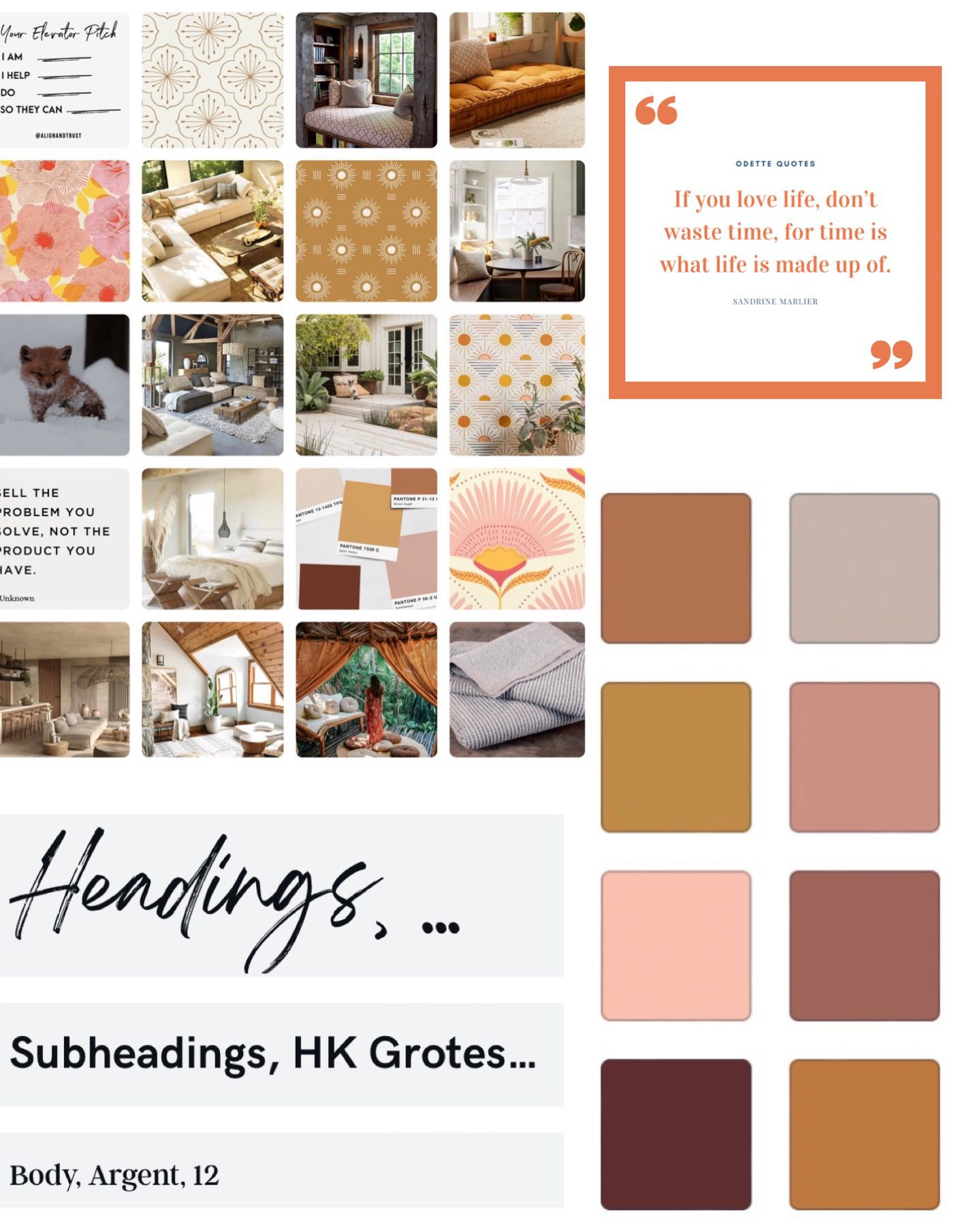
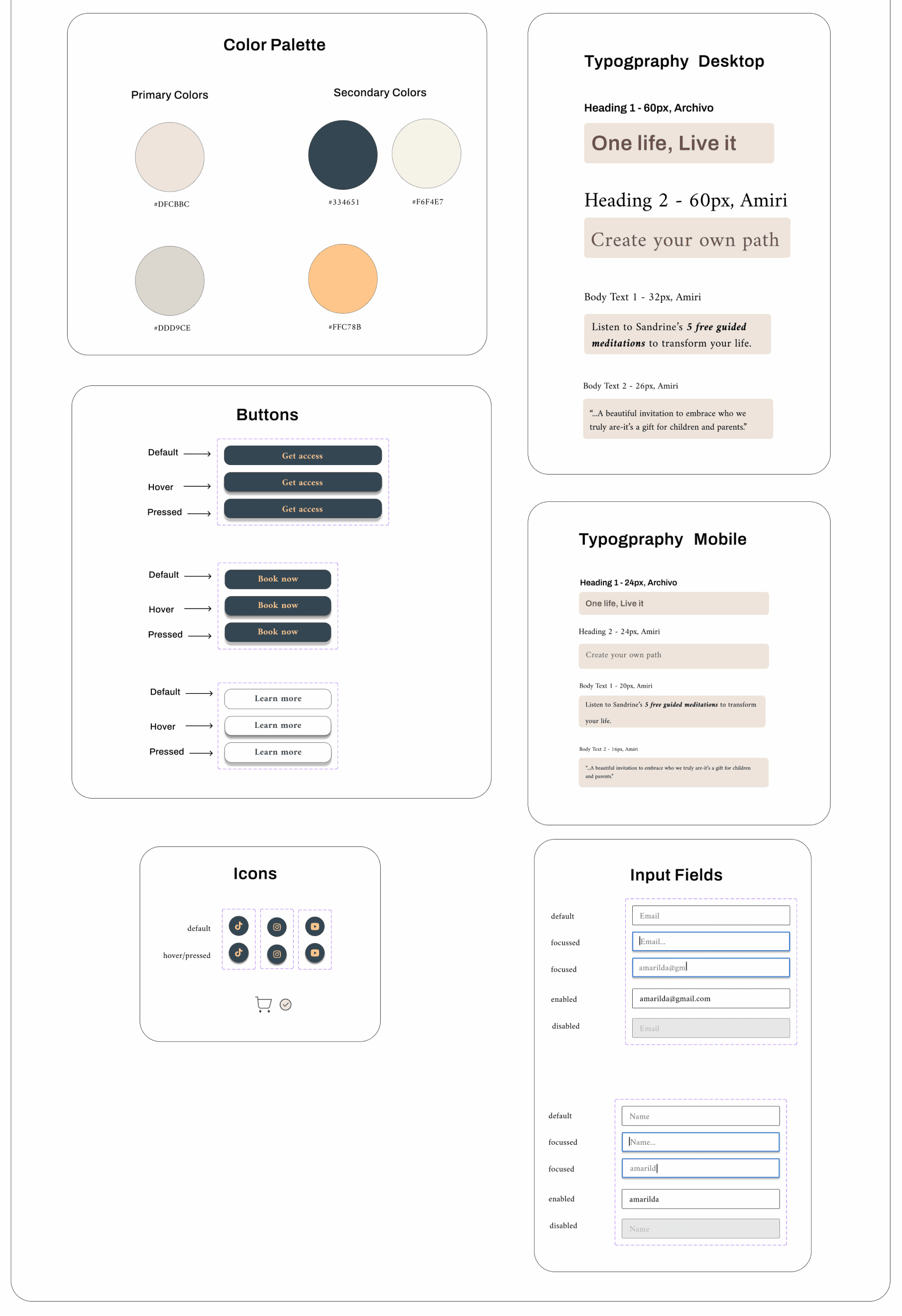
Wireframes
Low Fifelity
Outlining of a design to map out layout and functionality.
Client Feedback
A discussion to gather feedback on low-fidelity wireframes and refine the design direction.
High Fidelity
A detailed design representation that provides a close-to-final view of the website
First I sketched out some wireframes using the information gathered through the research. Then I digitalized them on this mid-fidelity wireframe where I included the most important information.
Then, I conducted a client interview where they gave me their feedback on mid fidelity wireframes. The next step would be designing High Fidelity Wireframes, using the UI kit.
After sharing the High Fidelity Wireframes with my client and receiving their approval, I was able to move forward with the Prototype:
Usability Testing
Usability Testing
Participants were able to complete the task. There was some confusion in page naming and button naming.
Test Conducting
For this assignment I conducted 5 usability tests with the users. They were asked to complete the task of purchasing “The Path Finder” course and adding to the cart another complementary service while I followed their behavior on Figma Prototype
Tasks
Task 1: Add to cart “The Path Finder” course
Task 2: Add to cart another complementary service coaching 1:1) and nish the purchasing process of both services
Test results
All the participants were able to finish the tasks without getting stuck.
Three of the participants had no confusion during the task and were able to complete the tasks smoothly.
Two of the participants were confused between the “Service” page and “Shop” page. They were expecting to find the courses under the “Shop” page so they browsed around the website before finding the course and purchasing it.
The naming of the buttons throughout the pages should be reconsidered according to their specific function.
iterations
Based on the feedback I changed the naming of the “Services” and the “Shop” for more clarity on what each page contains and the naming of the buttons according to their specific function in the page.
before & after
Final Product
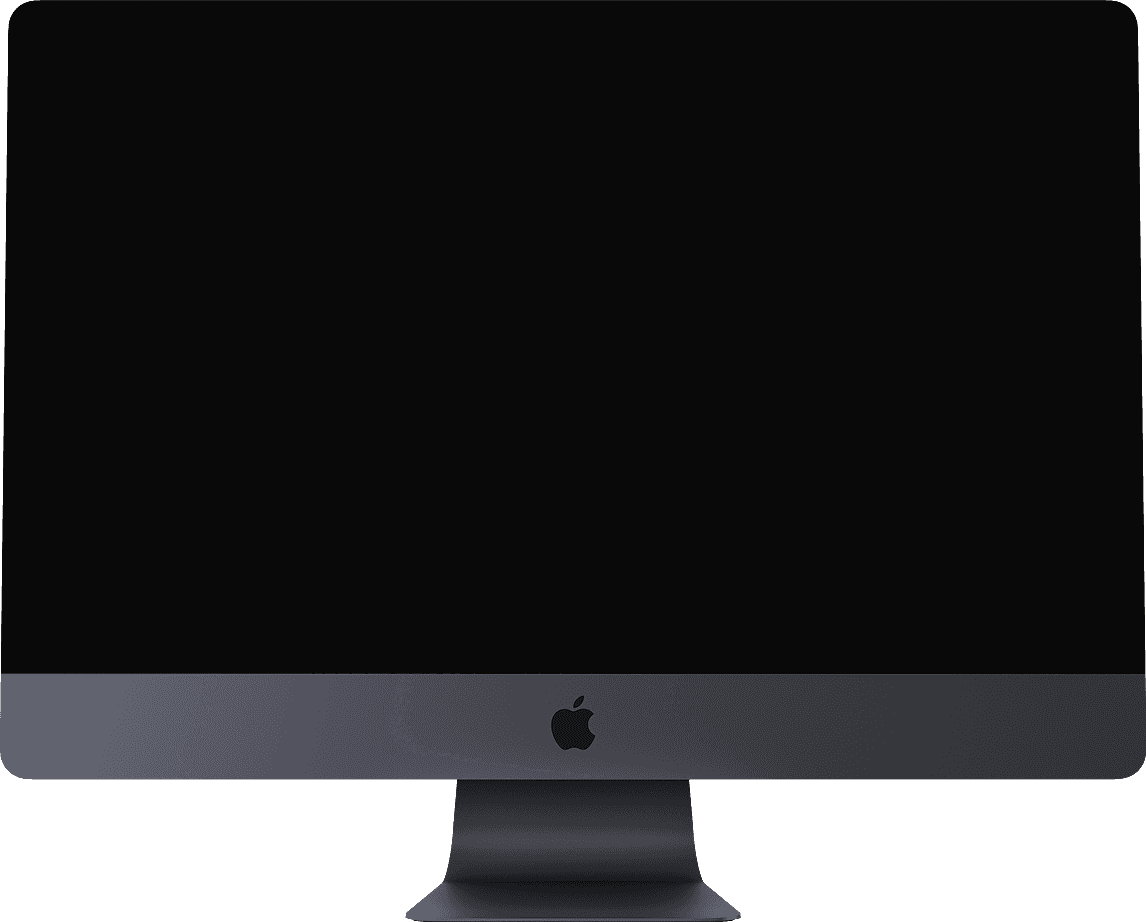
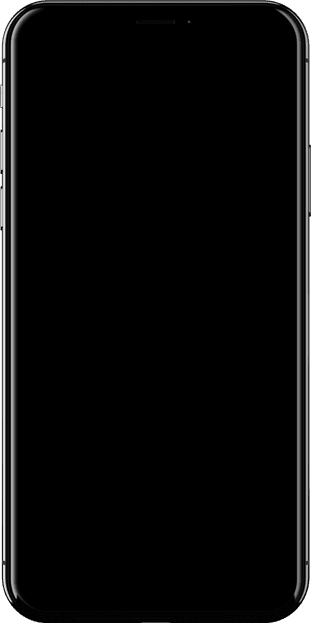
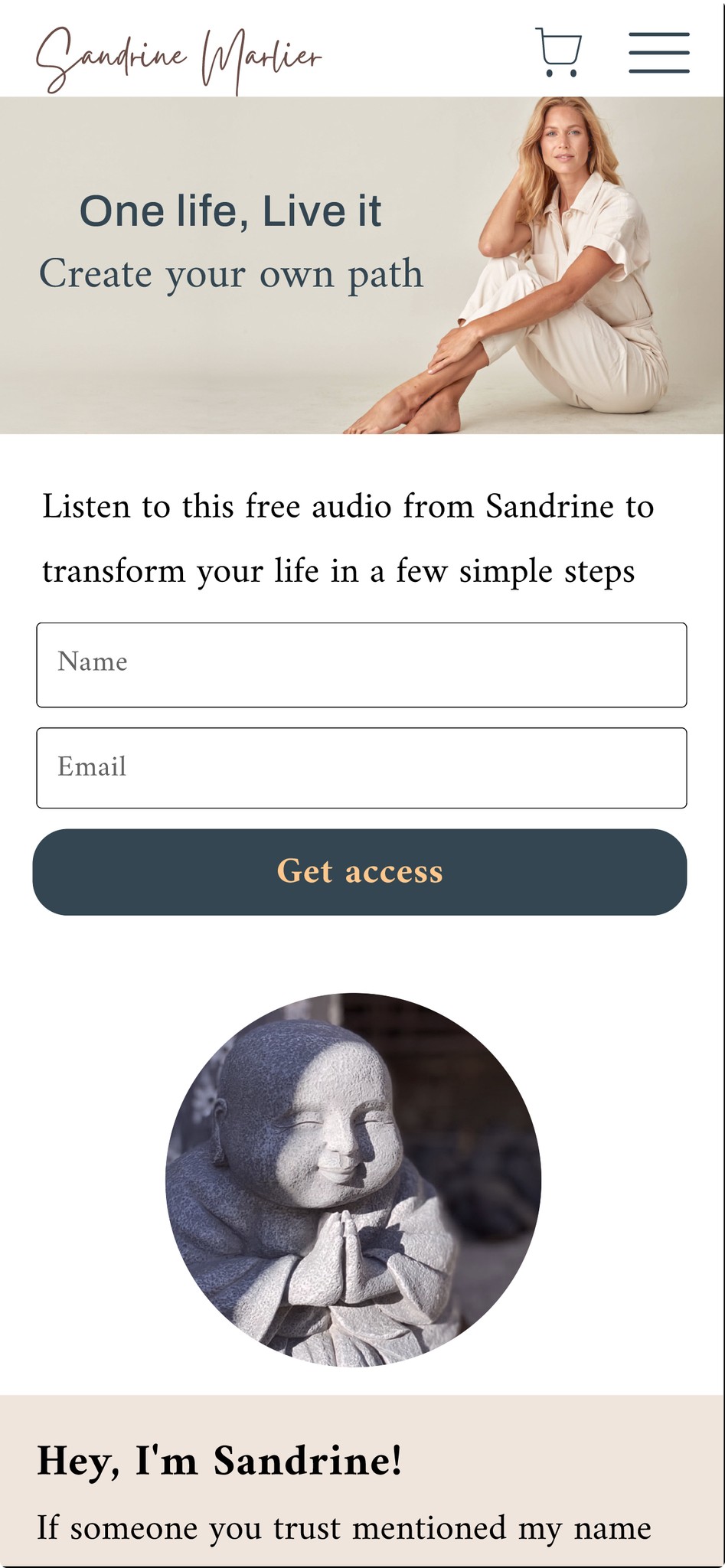
client’s feedback
After finalizing the high-fidelity wireframes, I presented the final product to the client. The client was pleased with both the design and the research findings related to her niche. She is now working on designing the courses based on the research results and user personas. Once the courses are completed, we will add the necessary screens and make any required changes before handing it over for development.
next steps
Course Design
The client will be designing products based on the research findings, focused on her newfound niche and target group.
Additional Screens
After the courses are ready to publish, I will make the necessary changes on the website related to these new services.
Developing
After the product is completely finalized including the website and the course design, the project will be handed over for development.
takeway learnings
Research is KEY
Through this project, I learned that research is a critical step not only in UX design but also in product design as a whole. It lays the foundation for building and developing both a successful business and a user-centered design.
AI as a tool
AI has been an invaluable tool in helping me write copy with a professional tone. I will soon be exploring ways to optimize the use of AI in UX design.
Through Feedback We Grow
Being open to feedback is crucial for my growth as a designer, and I am committed to continuing this practice.
